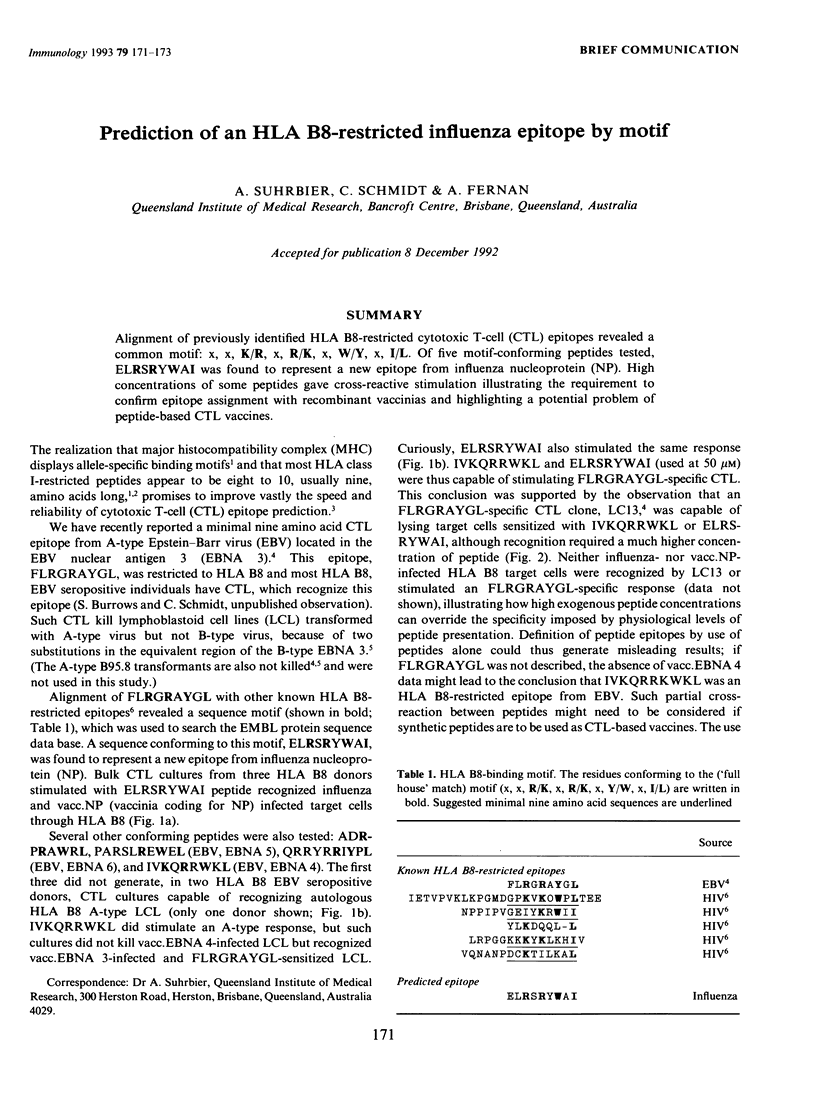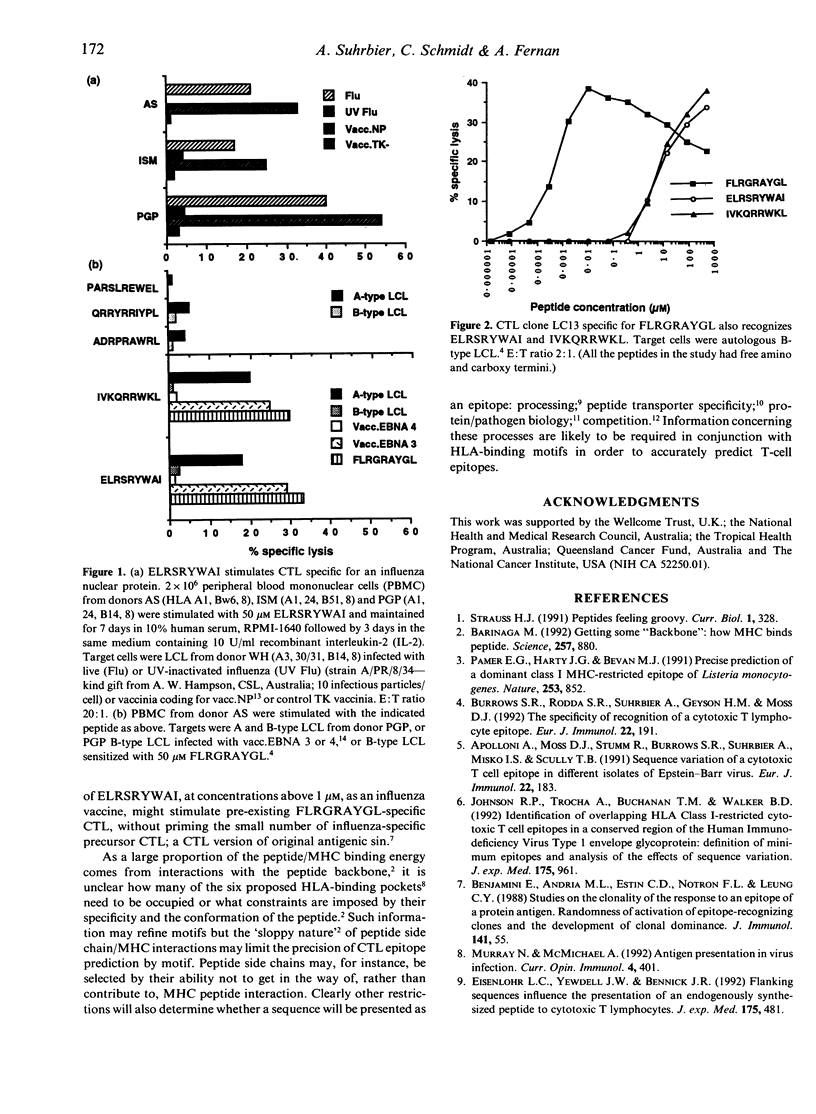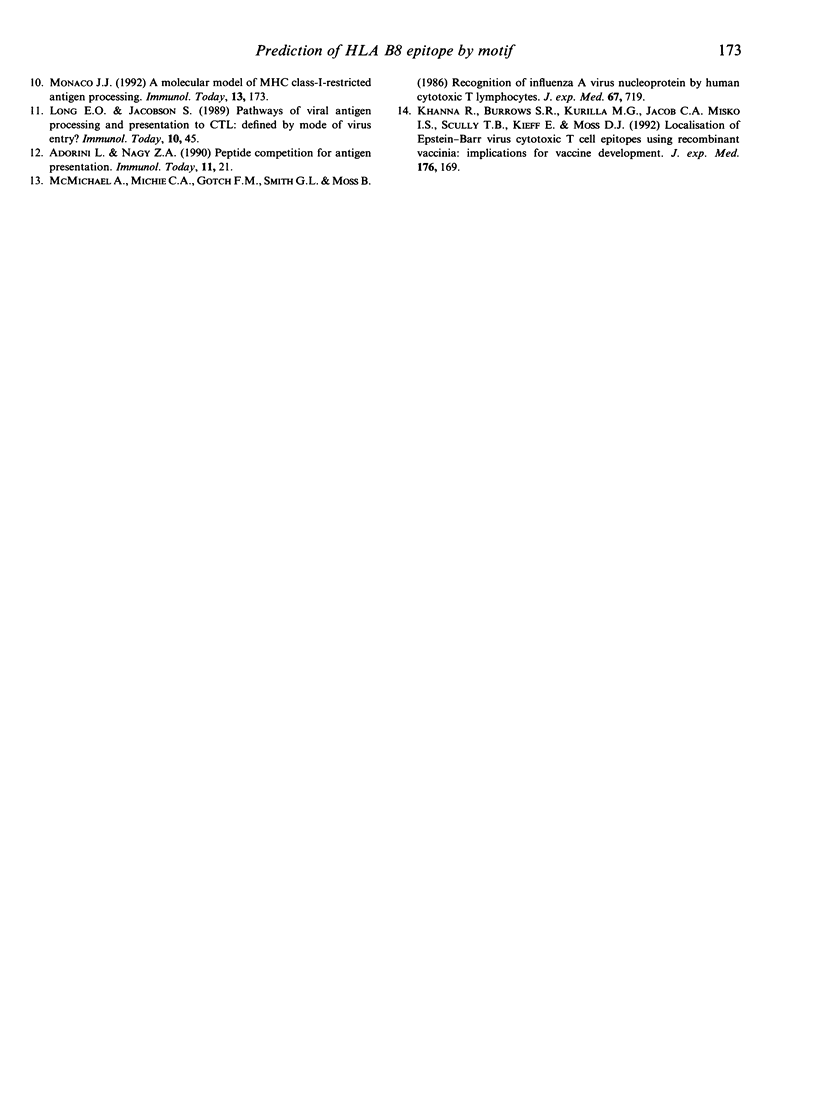Abstract
Alignment of previously identified HLA B8-restricted cytotoxic T-cell (CTL) epitopes revealed a common motif: x, x, K/R, x, R/K, x, W/Y, x, I/L. Of five motif-conforming peptides tested, ELRSRYWAI was found to represent a new epitope from influenza nucleoprotein (NP). High concentrations of some peptides gave cross-reactive stimulation illustrating the requirement to confirm epitope assignment with recombinant vaccinias and highlighting a potential problem of peptide-based CTL vaccines.
Full text
PDF


Selected References
These references are in PubMed. This may not be the complete list of references from this article.
- Adorini L., Nagy Z. A. Peptide competition for antigen presentation. Immunol Today. 1990 Jan;11(1):21–24. doi: 10.1016/0167-5699(90)90006-u. [DOI] [PubMed] [Google Scholar]
- Apolloni A., Moss D., Stumm R., Burrows S., Suhrbier A., Misko I., Schmidt C., Sculley T. Sequence variation of cytotoxic T cell epitopes in different isolates of Epstein-Barr virus. Eur J Immunol. 1992 Jan;22(1):183–189. doi: 10.1002/eji.1830220127. [DOI] [PubMed] [Google Scholar]
- Barinaga M. Getting some "backbone": how MHC binds peptides. Science. 1992 Aug 14;257(5072):880–881. doi: 10.1126/science.1502554. [DOI] [PubMed] [Google Scholar]
- Burrows S. R., Rodda S. J., Suhrbier A., Geysen H. M., Moss D. J. The specificity of recognition of a cytotoxic T lymphocyte epitope. Eur J Immunol. 1992 Jan;22(1):191–195. doi: 10.1002/eji.1830220128. [DOI] [PubMed] [Google Scholar]
- Eisenlohr L. C., Yewdell J. W., Bennink J. R. Flanking sequences influence the presentation of an endogenously synthesized peptide to cytotoxic T lymphocytes. J Exp Med. 1992 Feb 1;175(2):481–487. doi: 10.1084/jem.175.2.481. [DOI] [PMC free article] [PubMed] [Google Scholar]
- Johnson R. P., Trocha A., Buchanan T. M., Walker B. D. Identification of overlapping HLA class I-restricted cytotoxic T cell epitopes in a conserved region of the human immunodeficiency virus type 1 envelope glycoprotein: definition of minimum epitopes and analysis of the effects of sequence variation. J Exp Med. 1992 Apr 1;175(4):961–971. doi: 10.1084/jem.175.4.961. [DOI] [PMC free article] [PubMed] [Google Scholar]
- Khanna R., Burrows S. R., Kurilla M. G., Jacob C. A., Misko I. S., Sculley T. B., Kieff E., Moss D. J. Localization of Epstein-Barr virus cytotoxic T cell epitopes using recombinant vaccinia: implications for vaccine development. J Exp Med. 1992 Jul 1;176(1):169–176. doi: 10.1084/jem.176.1.169. [DOI] [PMC free article] [PubMed] [Google Scholar]
- Long E. O., Jacobson S. Pathways of viral antigen processing and presentation to CTL: defined by the mode of virus entry? Immunol Today. 1989 Feb;10(2):45–48. doi: 10.1016/0167-5699(89)90303-4. [DOI] [PubMed] [Google Scholar]
- McMichael A. J., Michie C. A., Gotch F. M., Smith G. L., Moss B. Recognition of influenza A virus nucleoprotein by human cytotoxic T lymphocytes. J Gen Virol. 1986 Apr;67(Pt 4):719–726. doi: 10.1099/0022-1317-67-4-719. [DOI] [PubMed] [Google Scholar]
- Monaco J. J. A molecular model of MHC class-I-restricted antigen processing. Immunol Today. 1992 May;13(5):173–179. doi: 10.1016/0167-5699(92)90122-N. [DOI] [PubMed] [Google Scholar]
- Murray N., McMichael A. Antigen presentation in virus infection. Curr Opin Immunol. 1992 Aug;4(4):401–407. doi: 10.1016/s0952-7915(06)80030-0. [DOI] [PubMed] [Google Scholar]


